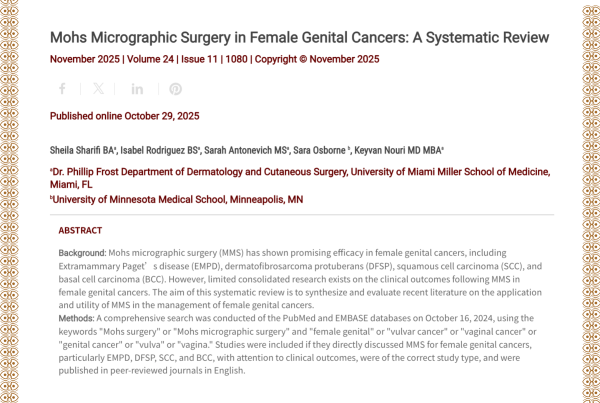JDD Resource Centers

Stay up-to-date on new clinical findings in Skin Cancer View the latest articles, case reports, supplements, Podcast episodes and more!
The Latest Clinical Findings in Skin Cancer
Discover the latest research in Skin Cancer: introducing the JDD Skin Cancer Resource Center.
Review clinical findings, articles, case reports, supplements, podcast episodes and more.
Skin Cancer Articles
-
Impact of a 31-gene Expression Profiling Test for Cutaneous Melanoma on Dermatologists’ Clinical Management Decision
Following a diagnosis of cutaneous malignant melanoma (CMM), patients are often guided for subsequent management by their dermatologist and national guideline recommendations. Based upon staging classification for CMM, guidelines recommend diagnostic tests and additional evaluation which may provide defined treatment protocols, surveillance, and follow-up.
-
A Randomized Trial of Broad Area ALA–PDT for Field Cancerization Mitigation in High-Risk Patients
Actinic keratoses (AKs) are precancerous, dysplastic epidermal lesions with potential for progression to squamous cell carcinoma (SCC). A study by Criscione et al1 revealed that in a high-risk population (≥2 keratinocyte carcinomas in previous 5 years), approximately 65% of all primary SCCs arose in lesions previously diagnosed as AKs. Furthermore, it demonstrated that the risk of malignant progression of AKs to primary SCC increases over time (0.6% at 1 year and 2.6% at 4 years).1 Cellular damage and atypia seen histologically in AKs are similar to those of surrounding nonlesional skin,2,3 suggesting that skin surrounding AKs may have an increased risk of skin cancer.
-
Multiple Primary Melanomas Occurring Around the Same Time: A Review of Terminology and Implications
Multiple primary melanomas (MPMs) have been reported to occur in 2-10% of melanoma patients. This study conducted a review of the literature to elucidate the definitions of terminology used to describe MPMs that were diagnosed in close temporal proximity as well as explore common risk factors. Terminology found in the literature included “concurrent”, “simultaneous” and “synchronous” with varying definitions that ranged from 0-6 months between diagnoses of the first and subsequent melanomas. Eight cases are described in chronological order, and the incidence of MPMs diagnosed around the same time were reported as 22-39%. Nevus spilus was identified as a potential risk factor for MPMs. This study highlights that MPMs are not uncommon, and clinicians should remain aware that MPMs can be diagnosed at or around the same time, warranting thorough skin exams.
Case Reports
-
Basal Cell Carcinoma in the Nasal Vestibule
Basal cell carcinomas (BCC) arise from DNA damage to cells of the basal layer of the epidermis and most commonly in areas of the skin exposed to sunlight or ultraviolet radiation. BCC is the most common skin cancer seen in humans with over 4.3 million cases reported in the United States and is responsible for 3-10% of all cancers annually. We report what we believe to be the first case of this very prevalent skin cancer arising in the nasal vestibule. The lesion was treated with Mohs micrographic surgery and required three stages to obtain histological clearance. Given the location of the tumor, Mohs surgery was chosen due to the procedure’s effectiveness for achieving the highest cure rate with the lowest incidence of tumor recurrence and for preserving as much adjacent healthy tissue as possible
-
Combination Topical Chemotherapy for the Treatment of an Invasive Cutaneous Squamous Cell Carcinoma
Standard of care for squamous cell carcinoma (SCC) is usually surgical, with either excision or Mohs micrographic surgery. However, surgery may not be ideal for elderly patients with numerous lesions, who are poor surgical candidates or who refuse surgery. Topical 5-fluorouracil (5-FU) and imiquimod have been studied off-label as monotherapies in the treatment of SCC in situ with promising results. However, long-term tumor-free survival rates are still less than with surgical management.
-
Recurrent Squamous Cell Carcinoma Arising Within a Linear Porokeratosis
Here we report a case of linear porokeratosis with recurrent malignant degeneration to squamous cell carcinoma (SCC) recurring six years after excision of initial SCC. A 79-year-old woman presented with a friable tumor located within a longstanding lesion on her posterior thigh. Six years prior, she was diagnosed with SCC arising within the same lesion, which had been surgically excised with negative margins. Physical examination revealed a 3.5 x 2.7 cm friable tumor on the left proximal posterior thigh.
You May Also Like









